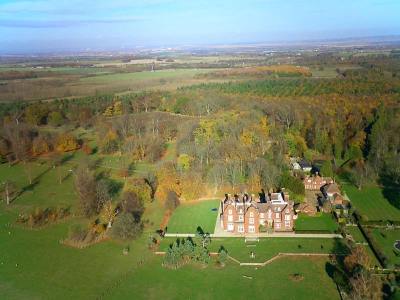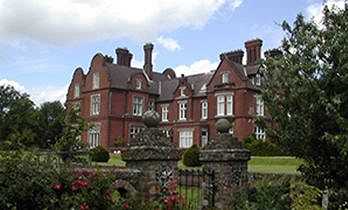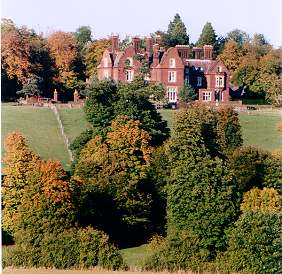Buildings Index
| Village
Home Page | Doddington Place Gardens
No.2. Doddington Place
 Doddington Place was built
in 1870, by Trollope, for Sir John Croft. A previous house, known
as Whitemans, had stood closer to the Faversham Road; it was pulled
down as requested in the will of the owner, who did not wish to
pass it to her next-of-kin.
Doddington Place was built
in 1870, by Trollope, for Sir John Croft. A previous house, known
as Whitemans, had stood closer to the Faversham Road; it was pulled
down as requested in the will of the owner, who did not wish to
pass it to her next-of-kin.
It was for this original property that the gas-yard
was constructed - later used to supply fuel for the larger
house on top of the hill. It is said that the bricks used for
the building were made at the village brick works, using clay
from the grounds of Doddington Place.

The Croft family - of Croft Original Sherry
fame - lived in the property from 1870 until 1906. It was then
purchased jointly by the Jeffreys and Oldfield families. The story
goes that the decision to buy was based on the magnificent view
alone, with the interior of the house unseen.
 To the South and East of the house there is
a ha ha, 13 feet high, of brick and flint panels 100 yards in
length; it runs into a terraced garden to the South East, with
red brick walls and arcaded upper sections, raised corner sections
and a flight of brick steps out into the gardens. These lovely
gardens, now open to the public, were designed by Maude Jeffreys,
a well-known 'character' in the Parish of Doddington.
To the South and East of the house there is
a ha ha, 13 feet high, of brick and flint panels 100 yards in
length; it runs into a terraced garden to the South East, with
red brick walls and arcaded upper sections, raised corner sections
and a flight of brick steps out into the gardens. These lovely
gardens, now open to the public, were designed by Maude Jeffreys,
a well-known 'character' in the Parish of Doddington.
The Edwardian front hall was added at a later stage, with heavy
and beautifully-carved Jacobean panelling to grace the interior.
The house itself is only a shadow of that originally intended
- which may account for the rather strange shape of the present
property. For whatever reason, it was decided to halt the building
operation well before completion.
 During the war years, the army
was billeted in the grounds in a number of Nissan huts. These
same huts were used for growing mushrooms between 1947 and 1979.
During the war years, the army
was billeted in the grounds in a number of Nissan huts. These
same huts were used for growing mushrooms between 1947 and 1979.
A degree of rivalry existed between Sharsted Court and Doddington
Place, heightened by the decision of the then Lord Harris to appoint
retired General Douglas Oldfield as the Colonel of the Home Guard
- in favour of Allured de-Laune, who felt he should have been
given the post.
Although there were a few tradesmen and shops in Doddington,
many of those who lived in the village were employees on the various
farms owned by either de Laune at Sharsted or the Oldfields at
Doddington Place. Between them, the two estates controlled, dominated
and employed almost every resident of the village. This situation
lasted until the First World War, since when fewer and fewer people
have been employed in and around the big houses.
 The folly in the garden of Doddington
Place, visible from the road between Newnham and Doddington, was
erected in 1997 by local builder Geoffrey Streeting and his team.
It is a memorial to Alexandra Oldfield who died in 1995. As befits
a folly, it was designed by an amateur - Richard Oldfield. It
is octagonal, built of brick and has two storeys, the lower having
napped flint facing. The folly serves no particular purpose other
than as an adornment and as a place from which to view the park
and the woodland garden.
The folly in the garden of Doddington
Place, visible from the road between Newnham and Doddington, was
erected in 1997 by local builder Geoffrey Streeting and his team.
It is a memorial to Alexandra Oldfield who died in 1995. As befits
a folly, it was designed by an amateur - Richard Oldfield. It
is octagonal, built of brick and has two storeys, the lower having
napped flint facing. The folly serves no particular purpose other
than as an adornment and as a place from which to view the park
and the woodland garden.
DODDINGTON PLACE GARDENS (See Website)
 Doddington Place has a large landscaped
garden set in an area of outstanding natural beauty. The 10 acre
garden was created by William Nesfield (1793 - 1881). He was arenowned
garden designer who worked on more than 200 gardens and estates
in England and Scotland. His work can still be seen in the gardens
at Harewood House, Kensington Gardens and Castle Howard. The partnerre
at Holkham Hall was his work as were some of the fine vistas at
Kew Gardens. At Doddington Place Nesfield incorporated the marvellous
views from the garden. The woodland garden is spectacular in the
spring when the azaleas, rhododendrons, and bulbs are in bloom.
The mixed borders of the formal terraces are full of colour in
late summer. There is also an Edwardian rock garden, fine trees
and lawns, impressive yew hedges and a new folly.
Doddington Place has a large landscaped
garden set in an area of outstanding natural beauty. The 10 acre
garden was created by William Nesfield (1793 - 1881). He was arenowned
garden designer who worked on more than 200 gardens and estates
in England and Scotland. His work can still be seen in the gardens
at Harewood House, Kensington Gardens and Castle Howard. The partnerre
at Holkham Hall was his work as were some of the fine vistas at
Kew Gardens. At Doddington Place Nesfield incorporated the marvellous
views from the garden. The woodland garden is spectacular in the
spring when the azaleas, rhododendrons, and bulbs are in bloom.
The mixed borders of the formal terraces are full of colour in
late summer. There is also an Edwardian rock garden, fine trees
and lawns, impressive yew hedges and a new folly.
Bygone Picture Gallery (click icons to enlarge)
 Doddington Place was built
in 1870, by Trollope, for Sir John Croft. A previous house, known
as Whitemans, had stood closer to the Faversham Road; it was pulled
down as requested in the will of the owner, who did not wish to
pass it to her next-of-kin.
Doddington Place was built
in 1870, by Trollope, for Sir John Croft. A previous house, known
as Whitemans, had stood closer to the Faversham Road; it was pulled
down as requested in the will of the owner, who did not wish to
pass it to her next-of-kin.
 To the South and East of the house there is
a ha ha, 13 feet high, of brick and flint panels 100 yards in
length; it runs into a terraced garden to the South East, with
red brick walls and arcaded upper sections, raised corner sections
and a flight of brick steps out into the gardens. These lovely
gardens, now open to the public, were designed by Maude Jeffreys,
a well-known 'character' in the Parish of Doddington.
To the South and East of the house there is
a ha ha, 13 feet high, of brick and flint panels 100 yards in
length; it runs into a terraced garden to the South East, with
red brick walls and arcaded upper sections, raised corner sections
and a flight of brick steps out into the gardens. These lovely
gardens, now open to the public, were designed by Maude Jeffreys,
a well-known 'character' in the Parish of Doddington. During the war years, the army
was billeted in the grounds in a number of Nissan huts. These
same huts were used for growing mushrooms between 1947 and 1979.
During the war years, the army
was billeted in the grounds in a number of Nissan huts. These
same huts were used for growing mushrooms between 1947 and 1979. The folly in the garden of Doddington
Place, visible from the road between Newnham and Doddington, was
erected in 1997 by local builder Geoffrey Streeting and his team.
It is a memorial to Alexandra Oldfield who died in 1995. As befits
a folly, it was designed by an amateur - Richard Oldfield. It
is octagonal, built of brick and has two storeys, the lower having
napped flint facing. The folly serves no particular purpose other
than as an adornment and as a place from which to view the park
and the woodland garden.
The folly in the garden of Doddington
Place, visible from the road between Newnham and Doddington, was
erected in 1997 by local builder Geoffrey Streeting and his team.
It is a memorial to Alexandra Oldfield who died in 1995. As befits
a folly, it was designed by an amateur - Richard Oldfield. It
is octagonal, built of brick and has two storeys, the lower having
napped flint facing. The folly serves no particular purpose other
than as an adornment and as a place from which to view the park
and the woodland garden. Doddington Place has a large landscaped
garden set in an area of outstanding natural beauty. The 10 acre
garden was created by William Nesfield (1793 - 1881). He was arenowned
garden designer who worked on more than 200 gardens and estates
in England and Scotland. His work can still be seen in the gardens
at Harewood House, Kensington Gardens and Castle Howard. The partnerre
at Holkham Hall was his work as were some of the fine vistas at
Kew Gardens. At Doddington Place Nesfield incorporated the marvellous
views from the garden. The woodland garden is spectacular in the
spring when the azaleas, rhododendrons, and bulbs are in bloom.
The mixed borders of the formal terraces are full of colour in
late summer. There is also an Edwardian rock garden, fine trees
and lawns, impressive yew hedges and a new folly.
Doddington Place has a large landscaped
garden set in an area of outstanding natural beauty. The 10 acre
garden was created by William Nesfield (1793 - 1881). He was arenowned
garden designer who worked on more than 200 gardens and estates
in England and Scotland. His work can still be seen in the gardens
at Harewood House, Kensington Gardens and Castle Howard. The partnerre
at Holkham Hall was his work as were some of the fine vistas at
Kew Gardens. At Doddington Place Nesfield incorporated the marvellous
views from the garden. The woodland garden is spectacular in the
spring when the azaleas, rhododendrons, and bulbs are in bloom.
The mixed borders of the formal terraces are full of colour in
late summer. There is also an Edwardian rock garden, fine trees
and lawns, impressive yew hedges and a new folly.